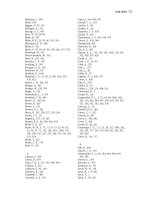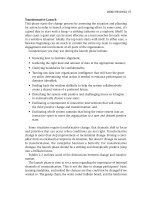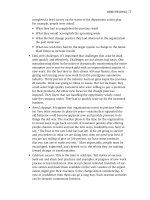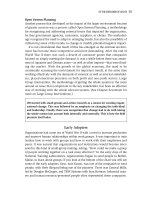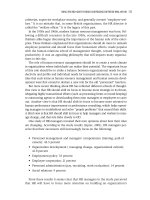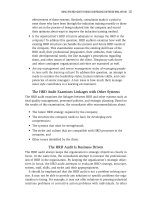Practicing Organization Development (A guide for Consultants) - Part 65 doc
Bạn đang xem bản rút gọn của tài liệu. Xem và tải ngay bản đầy đủ của tài liệu tại đây (370.85 KB, 10 trang )
Mindset
While attachment holds us locked into a belief, mindset provides the opportu-
nity to hold contradictions such as deficit- or strength-based beliefs or seeing
the glass as half-empty or half-full. In The Change Leader’s Roadmap, Linda
Ackerman Anderson and Dean Anderson (2001) say, “The mindset of the leader
has a major impact on the meaning made” of information contained in a busi-
ness wake-up call. In comparing the Industrial Mindset with the Emerging
Mindset, we can imagine how a leader could miss clues provided in everyday
incidences. (See Table 26.1.)
Mindset colors the way that we approach information and relationships,
which limits how to utilize our personhood as the instrument of change.
Projection
Projection is actually “me” wrestling with “myself” or at least that part of myself
that I am noticing in another. Projection is probably the most active element that
stands in the way of accurate perception.
An emotional reaction is usually a clue to a projection. The emotion could
be attraction, curiosity, or wonderment, which is noticing what I like in myself.
Or the emotion could be anger, dislike, distrust, or judgment, which is noticing
ADDING TO THE COMPLEXITY OF PERSONAL CHANGE 611
Table 26.1. Industrial Mindset vs. Emergent Mindset
The Industrial Mindset The Emergent Mindset
“Reality as a Great Machine” “Reality as a Living System”
Separate Parts Wholeness/Relationship
Power and Control Co-Create and Participate
Certainty/Predictability Uncertainty/Probability
Objective/Knowable Subjective/Mysterious
Discrete Events Continuous Process
Entropy Self-Organization
Order into Chaos Order out of Chaos
External Causation Internal Causation
Scarcity Abundance
From The Change Leader’s Roadmap, by Linda Ackerman Anderson and Dean Anderson. Published by
Pfeiffer, 2001. Used with permission.
34_962384 ch26.qxd 2/3/05 12:21 AM Page 611
in someone else what I don’t like in myself. It does not matter what emotion
shows up. The point is to recognize that an emotional reaction is the greatest
clue that a projection has been triggered. The deep work is to understand the
source of the projection. The source of the projection could be an early child-
hood relationship or incident, a trauma that is unresolved, or a significant event
that has yet to be integrated. When an emotion surfaces while working with a
client, it is important to not disengage from the client in order to understand
the projection or analyze the source. If I am able to notice my “friend, the emo-
tion,” I can form an agreement with myself that I will come back for self-study
when I am not in service to the client. This clears the boundary between my
work and my clients so we can proceed in a healthy way.
Knowing that an accurate perception is hindered by blocks, denial, attachment,
mindset, and projection can provide a lifetime of self-study that may seem daunt-
ing. We have the gift of emotion that can act as our guide. If we do not pay atten-
tion to our emotions, we are at risk of losing our effectiveness with the client,
family, or individual system. Too much is at risk for us to be hiding from ourselves.
DESCRIBE
Perceive and describe are two steps that are so close together that they may seem
inseparable, but they are distinct. To perceive is to have consciousness of some-
thing; to describe is to name what that something is (see Figure 26.3).
When we describe something, we bring language to a perception. We may
say, “I have an idea, my intuition is telling me, I am feeling an emotion—which
is. . . .” Language is how we make sense out of the world.
For some of us, our preference is to describe our perceptions using the lan-
guage of the five senses: seeing, hearing, smelling, touching, and tasting. For
others, there is a sixth sense, intuition. An accurate understanding of our senses
comes from early childhood validation. If I smell cinnamon but have been told
that smell is nutmeg, I may learn that cinnamon is something that it is not. The
same is true of emotions. If I learn that only little children cry and that, as an
adult, it is not appropriate to cry, I will learn that crying is not an acceptable
emotion to have and therefore will stuff that emotion rather than be unaccept-
able. If I learn that acknowledging fear will cause me to be called a “fraidy cat,”
then I will find ways to deny my fears.
The result of these confusing messages is that we are unable to describe
accurately what is going on within ourselves. We learn to distrust the language
of the emotions. We therefore distrust our self-awareness. I have this wonder-
ful image of a canvas with a face outlined as a painting-by-numbers. Part of the
face is filled in with vibrant and accurate colors. Part of the picture, yet to
be painted, is outlined according to the color that is to be applied “by the
612 PRACTICING ORGANIZATION DEVELOPMENT, 2ND EDITION
34_962384 ch26.qxd 2/3/05 12:21 AM Page 612
numbers.” When I look at this picture, I see a partial picture and my imagina-
tion is left to fill in the empty spots. I could hope the rest of the picture will be
like the “filled-in portion” or I could fear that the unpainted part is actually ugly
or representative of my undisclosed shadow. This image helps me to understand
the concept of “mask making” described by Tannenbaum and Eisen in the prior
chapter. For me, mask making is my way of putting on a particular face until I
can find the language to describe what I am perceiving.
The down side is that, while I am wearing this mask, I am certain that others
experience me as not being authentic. My tentativeness, caused by my effort to
protect my self-image, gets in my way of relating to others. If I cannot describe
what is going on with myself, how can the client rely on me to describe what
they are experiencing?
ACCEPT
After perceiving and describing, the third step in the active change model is to
accept “what is for what it is.” When we are in acceptance, we are not arguing
about whether or not something should have happened. Acceptance also does not
mean I like or dislike it. If I notice something, it will remain as it is, regardless of
ADDING TO THE COMPLEXITY OF PERSONAL CHANGE 613
Hear
Feel
(Touch)
Smell
Sixth Sense
(Intuition)
TasteSee
Describe
Figure 26.3. Describing
34_962384 ch26.qxd 2/3/05 12:21 AM Page 613
whatever opinion I have about it. The desired state would be unconditional accep-
tance. Getting in the way of unconditional acceptance are blame, shame, guilt,
and judgment, which are responses that help me to remain the victim or to
assume I am without power to make a change (see Figure 26.4).
Blame is where I make someone else wrong for what is going on with me.
The classical examples include: “This is the belief system I was raised with,”
“But this is just our corporate culture—I have to act this way to survive,” or
“Our company situation is the fault of the leadership team.” Blame is where I
set up a reason or excuse that resides outside of me. What a perfect way to
avoid taking responsibility for my current state of being!
Shame is where I make myself wrong. “I should have known better,” “If I
had only done . . . things might be different,” “Wow, that was really stupid!”
Guilt is the state of holding onto the fact that I was wrong. It is a way of com-
pounding the shame, giving it a much more lasting force. We can hold onto guilt
for ages as a way of holding ourselves in a pattern that we are just not ready to
change yet.
Judgment is what we are doing when we are not accepting. Judgment is
where we insert the perception of right or wrong about something that already
exists. Judgment triggers a struggle for control, which can only be a temporary
614 PRACTICING ORGANIZATION DEVELOPMENT, 2ND EDITION
Accept
Blame
Shame
Guilt
Judgment
Figure 26.4. Accepting
34_962384 ch26.qxd 2/3/05 12:21 AM Page 614
state because the only thing we can realistically control is what is going on
inside of ourselves.
Acceptance helps us leave the state of reaction and come to a state of neu-
trality and awareness so that we can make a choice to see the issue differently
or to re-start the same issue with a different approach. Thus we are on the path
of active change.
QUESTION
It is our responsibility to discover for ourselves what might be getting in the
way of a healthy interaction with others. Being on a quest and asking good
questions is a powerful skill we often practice with others. We use questions to
help others find themselves. Questions open the door to possibilities. With ques-
tions, we can cultivate a greater awareness of a situation, become more creative
in developing choices, and avoid getting stuck asking the same questions over
and over again and getting the same answers. Questions help us reach the best
action possible from the available known options.
We can learn from the answers to our questions. We can also learn from how
we formulate the questions and the impact they have on us. We should notice
that formulating questions actually helps us to listen, find deeper meaning, stim-
ulate thinking, and inspire our personal development.
On the road to becoming a “master question asker” are several paths to be
aware of (see Figure 26.5):
ADDING TO THE COMPLEXITY OF PERSONAL CHANGE 615
The Problem
State of Being
Intuition
Timing
The Insight
?
Knowledge
Risk
Question
Figure 26.5. Questioning
34_962384 ch26.qxd 2/3/05 12:21 AM Page 615
• State of being: If we approach our issues as a curious and wondering
person, we are in a state of being where we consider ourselves a wise
and valuable investment. We want to learn about ourselves more than
we want to keep the status quo. We have a way of “checking out” our
assumptions. Being in a creative state, the question becomes the begin-
ning of creation.
• The problem: Sometimes what appears to be the problem is actually a
symptom. When the question is, “What is the solution?” we often miss
the underlying possibility. If I ask myself, “Do I set myself up for failure?”
I will get a yes-or-no answer. However, if I ask, “How do I set myself up
for failure?” I will get closer to the core of myself that I wish to explore.
• The insight: By stating my own question and then really looking at it, I
can explore the energy behind the question, the awareness inspired by
the question, and the assumptions within the question. By consciously
looking at how we are phrasing the questions to ourselves, we will be
able to break beyond our perceptions of what is happening and gain
insight into our personal state.
• Timing: Bob Tannenbaum often told me that this is the trickiest part of
our own development. Right timing of questions and self-reflection
depends on our ability to be in “the here and now.” It is important to
understand why we are asking ourselves a question, what we will do
with the answer when it shows up, and whether we are willing and able
to take a risk with that answer. When we decide that now is not the
right time to be asking questions of ourselves, we are actually making a
choice to take no action—at this time!
• Risk: Good questions will stir things up and can be painful to both ask
and answer. Understanding that opening what has been covered up can
be the beginning of healing helps us to be courageous in asking ques-
tions. The question can be one that we have never asked ourselves
before, challenges our expectations, or opens us to the unknown. The
challenge is to understand whether we are avoiding the risky questions
out of habit, fear, blind spots, or assumptions.
• Intuition: Every question is an experiment. I have learned that if I try to
ignore a question that keeps coming back, my subconscious really
wants me to explore this question. This persistent question may be the
doorway to a profound awareness in the hidden library of information
residing within myself. My use of curiosity and inner clues helps me to
ask questions about what has been in my periphery.
• Knowledge: If what I know about myself is limiting my capabilities, I
may want to find out more. It is easy for OD practitioners to acknowl-
edge there is theory or practice knowledge needing development. It is
616 PRACTICING ORGANIZATION DEVELOPMENT, 2ND EDITION
34_962384 ch26.qxd 2/3/05 12:21 AM Page 616
harder to acknowledge there may be something within myself I don’t
understand or fully grasp. If I can engage in friendly debate, talk to oth-
ers with different views, read, or push my edges, I can encourage myself
along the path of finding my own solutions, which will result in my par-
ticipating in the development of me actively and consciously.
ACT
This is where personal development efforts frequently fail. Taking action means
I have to step forward, take a risk, assume a position, be open for failure, go
into the unknown.
We know when we ask questions, we will get answers. The internal cycle
would probably look like: We receive an answer to our question. → The answer
brings us a new revelation. → The new revelation is a new perception. → We
describe it and accept it. We ask a new question. → A new question is an
action. → We start all over.
Our response at each of stage will be based on personal choice and timing.
(See Figure 26.6.) There is a choice when we say: “I understand what I need to
ADDING TO THE COMPLEXITY OF PERSONAL CHANGE 617
Choice
Timing
Risk
Act
Figure 26.6. Acting
34_962384 ch26.qxd 2/3/05 12:21 AM Page 617
do but would like to do it later.” “I think I need to gather more data and to think
about this more.” “I can see the steps that I need to take but will take them
later.” “I am prepared to take action now.”
When we make a commitment to move forward based on what we know in
the moment, we are practicing active change rather than being in reactive
change and being in response from something outside of ourselves.
CHANGE
For a change to be active, what is internal must be brought forward into phys-
ical action before it can be complete. Without the physical manifestation, we
are only working with theory. With a physical step, we can arrive at a new place
and things look different to us. The circumstances will be different. We will be
in a new “here and now.” (See Figure 26.7.)
REPEATING THE PROCESS
The study of the self is the greatest and most difficult subject of all. We are com-
plex beings seeking to do complex human systems work in ever-changing con-
ditions. Our sharpness depends on our ability to be more fluid in our change.
618 PRACTICING ORGANIZATION DEVELOPMENT, 2ND EDITION
New Place
Different
Circumstances
New
“Here” and “Now”
Change
Figure 26.7. Changing
34_962384 ch26.qxd 2/3/05 12:21 AM Page 618
With the “active change model,” it is possible to continue the process of explo-
ration of “the self as the instrument of change” within our own timing and capa-
bilities and work on developing that fluidity. Our significance sometimes
remains obscure until we embark on the journey of personal change. Our sig-
nificance then becomes that we are able to bring more of who we are into the
work that we do and are thus more available to be of service to others.
References
Ackerman Anderson, L., & Anderson, D. (2001). The change leader’s roadmap: How to
navigate your organization’s transformation. San Francisco: Pfeiffer.
Quade, K., & Brown, R., (2002). The conscious consultant: Mastering change from the
inside out. San Francisco: Pfeiffer.
ADDING TO THE COMPLEXITY OF PERSONAL CHANGE 619
34_962384 ch26.qxd 2/3/05 12:21 AM Page 619
CHAPTER TWENTY-SEVEN
Practicing Internal OD
Allan Foss, David Lipsky, Allen Orr, Beverly Scott,
Terrence Seamon, Julie Smendzuik-O’Brien, Anna Tavis,
Dale Wissman, and Catherine Woods
M
any writers and experts in the field of OD have historically assumed that
practicing OD is similar for the internal OD practitioner and external OD
practitioner. Both internals and externals bring technical expertise, com-
mitment to helping their clients, and a belief in the values and principles of the
field. However, the setting and environment of the practice as an employee of
the organization creates different requirements, advantages, and challenges for
the internal practice of OD.
In this chapter we explore those differences, identify the advantages of inter-
nal organization development, discuss the organizational context in which
internal OD practitioners operate, consider competencies needed by the inter-
nal practitioner, and offer distinctions between the practice and partnership of
internal and external OD practitioners.
The authors of this chapter either have been or are now internal practition-
ers and bring their own experienced perspectives to describe these differences.
However, to expand that perspective, twelve internal practitioners were inter-
viewed for this chapter. These internal OD practitioners serve in a range of
industries: financial services, consumer goods, information technology and soft-
ware, energy, higher education, transportation services, bio-genetics, telecom-
munications, and government. The questions used in the interviews appear in
Exhibit 27.1.
Organization development promotes the improvement, enhances the perfor-
mance, and supports the integrated effectiveness of the whole organization.
620
∂
∂
35_962384 ch27.qxd 2/3/05 12:20 AM Page 620
